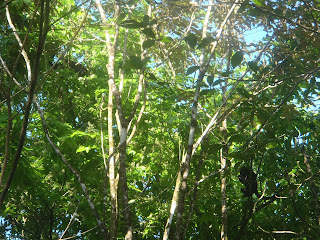Spoiler alert: I apologize for lack of
(relevant) pictures in this blog.
The first encounter was a week or two ago
when we ran into a group of Ph.D. students from the US on the beach at night,
with a turtle. This was rather strange for two reasons. First, the beach here,
Playa Norte, is protected and therefore, the public cannot access it between
6pm and 5am. Second, in order to be on the beach during those hours one needs a
permit from MINAET (the Costa Rican Ministry of the Environment, Energy and
Telecommunications). After a bit of chatting it was clear that this group
of Bison and Frog Ph.D. students were unaware that they did not have
permits for being on the beach. However, from doing a bit of investigation
ourselves, it was clear that they did not actually have permission or permits
to be there.
The second encounter happened just last
week when while "working" a leatherback turtle, the person in the
house behind the beach where she was nesting came out with a small group to see
the turtle. To be honest I can't really say how I feel about this. The beach is
protected, but people seeing turtles nest is important to raise awareness about
the importance of their conservation. However, after hearing stories of this
particular individual feeding past volunteers turtle eggs...I don't know how to feel
about the situation.
Finally, the last story I was not actually
there for, but was told when the night patrol returned a couple of
nights ago. While out on the beach our patrol team came across a family digging
in the sand. Our team passed them at first but on the way back, when they
finally approached them, the reaction was surprising. Lots of giggles, while
they (pretended? - or didn't pretend) to build a sand turtle sculpture. This
caused some suspicion -- were they poaching a nest? Trying to help hatchlings
out of their nests? When our patrol team went out the next morning they looked
for signs of a poached nest where the group had been the night before, but did
not find anything. So although the family wasn't legally allowed to be out on
the beach at that particular time, they weren't causing any direct harm.
What confuses me most about all of these things
is where does one draw the boundary of telling people -- especially the
local community -- what they can and can't do when it comes to something they
have been doing for centuries.
Whether the people on the beach at night
are families playing (or not?), curious locals (that occasionally poach?) and
university groups (that don't have permits?) -- what are the boundaries?
To lighten it up here are some photos of some of our friends that hang out around base...please enjoy!
 |
| Proboscis Bats that hang out under the dock. |
 |
| Howler Monkeys that like waking us up in the mornings. |
 |
| White-faced Capuchin Monkey in the tree outside our rooms. |
 |
| Strawberry Poison Dart Frog who hangs out by the washrooms. |
 |
| Slaty-tailed Trogan outside the kitchen. |
 |
| Sarah's picture of a Slaty-tailed Trogan posing! |
 |
| Juancho the Caiman who hangs out under the dock. |
Thanks to Sarah for taking some of these pictures with her wicked camera - check out her blog at: http://roamingfrijole.blogspot.com/.











